UK Social Care: Addressing Disadvantages of Aged Service Users
VerifiedAdded on 2023/06/15
|8
|2347
|117
Essay
AI Summary
This essay examines the disadvantages and social exclusion faced by physically disabled older adults residing in the UK, who are part of the social care service user group. It highlights the role of the government and society in exacerbating these challenges, including inadequate funding, lack of trained workforce, attitudinal barriers, and communication difficulties. The essay also provides recommendations to overcome these challenges, such as proactive government policies, integrated care frameworks, and the promotion of aging-friendly communities. The author emphasizes the importance of addressing social stigmatization and improving communication technologies to enhance the quality of life and social inclusion for this vulnerable population. Desklib offers a platform for students to access this essay and other study resources.
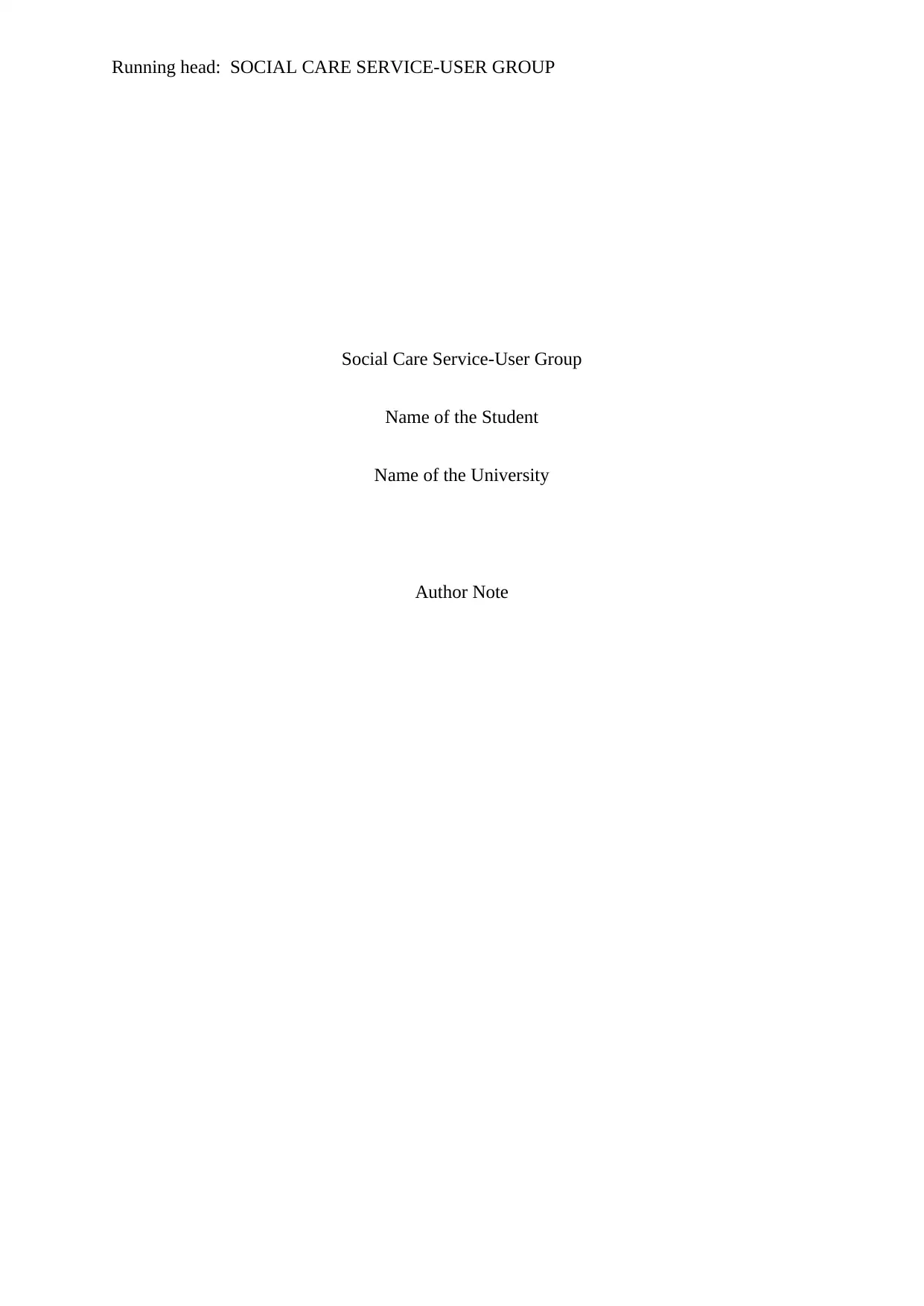
Running head: SOCIAL CARE SERVICE-USER GROUP
Social Care Service-User Group
Name of the Student
Name of the University
Author Note
Social Care Service-User Group
Name of the Student
Name of the University
Author Note
Paraphrase This Document
Need a fresh take? Get an instant paraphrase of this document with our AI Paraphraser
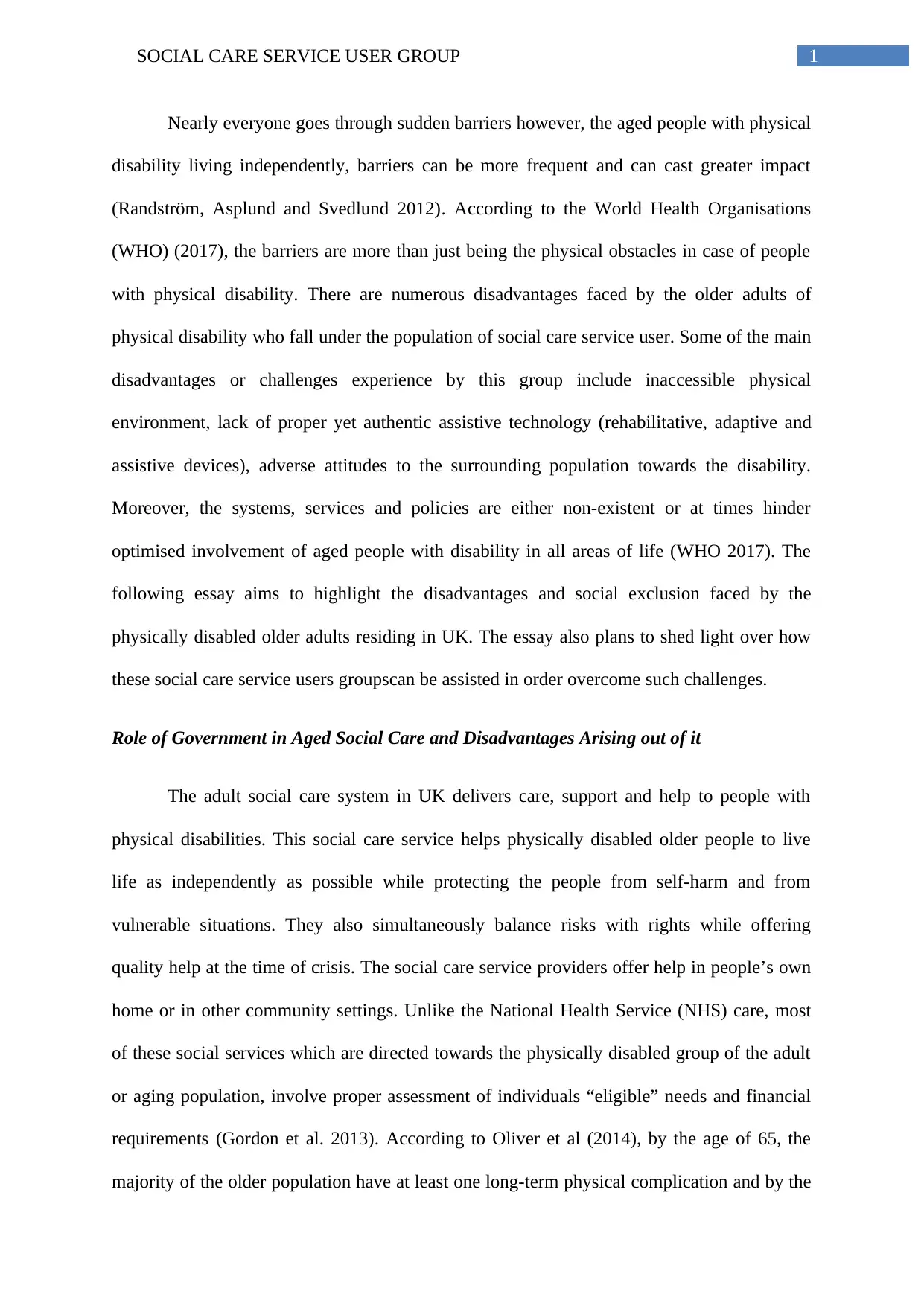
1SOCIAL CARE SERVICE USER GROUP
Nearly everyone goes through sudden barriers however, the aged people with physical
disability living independently, barriers can be more frequent and can cast greater impact
(Randström, Asplund and Svedlund 2012). According to the World Health Organisations
(WHO) (2017), the barriers are more than just being the physical obstacles in case of people
with physical disability. There are numerous disadvantages faced by the older adults of
physical disability who fall under the population of social care service user. Some of the main
disadvantages or challenges experience by this group include inaccessible physical
environment, lack of proper yet authentic assistive technology (rehabilitative, adaptive and
assistive devices), adverse attitudes to the surrounding population towards the disability.
Moreover, the systems, services and policies are either non-existent or at times hinder
optimised involvement of aged people with disability in all areas of life (WHO 2017). The
following essay aims to highlight the disadvantages and social exclusion faced by the
physically disabled older adults residing in UK. The essay also plans to shed light over how
these social care service users groupscan be assisted in order overcome such challenges.
Role of Government in Aged Social Care and Disadvantages Arising out of it
The adult social care system in UK delivers care, support and help to people with
physical disabilities. This social care service helps physically disabled older people to live
life as independently as possible while protecting the people from self-harm and from
vulnerable situations. They also simultaneously balance risks with rights while offering
quality help at the time of crisis. The social care service providers offer help in people’s own
home or in other community settings. Unlike the National Health Service (NHS) care, most
of these social services which are directed towards the physically disabled group of the adult
or aging population, involve proper assessment of individuals “eligible” needs and financial
requirements (Gordon et al. 2013). According to Oliver et al (2014), by the age of 65, the
majority of the older population have at least one long-term physical complication and by the
Nearly everyone goes through sudden barriers however, the aged people with physical
disability living independently, barriers can be more frequent and can cast greater impact
(Randström, Asplund and Svedlund 2012). According to the World Health Organisations
(WHO) (2017), the barriers are more than just being the physical obstacles in case of people
with physical disability. There are numerous disadvantages faced by the older adults of
physical disability who fall under the population of social care service user. Some of the main
disadvantages or challenges experience by this group include inaccessible physical
environment, lack of proper yet authentic assistive technology (rehabilitative, adaptive and
assistive devices), adverse attitudes to the surrounding population towards the disability.
Moreover, the systems, services and policies are either non-existent or at times hinder
optimised involvement of aged people with disability in all areas of life (WHO 2017). The
following essay aims to highlight the disadvantages and social exclusion faced by the
physically disabled older adults residing in UK. The essay also plans to shed light over how
these social care service users groupscan be assisted in order overcome such challenges.
Role of Government in Aged Social Care and Disadvantages Arising out of it
The adult social care system in UK delivers care, support and help to people with
physical disabilities. This social care service helps physically disabled older people to live
life as independently as possible while protecting the people from self-harm and from
vulnerable situations. They also simultaneously balance risks with rights while offering
quality help at the time of crisis. The social care service providers offer help in people’s own
home or in other community settings. Unlike the National Health Service (NHS) care, most
of these social services which are directed towards the physically disabled group of the adult
or aging population, involve proper assessment of individuals “eligible” needs and financial
requirements (Gordon et al. 2013). According to Oliver et al (2014), by the age of 65, the
majority of the older population have at least one long-term physical complication and by the

2SOCIAL CARE SERVICE USER GROUP
age of 75 this number increases to two. According to the National Audit Office (2016), 62%
of all hospital admission per day is registered against the older people who are above 65 years
of age. The National Health Service too is under immense pressure even though the funding
coming from NHS is protected in comparison with the funding received by the local
authorities. Healthcare organisations have also struggled in order to satisfy the requirements
of the aged age group in a periodic manner in both emergency and inpatients departments
(Care Quality Commission 2015). In the majority of cases, the health and the social care
services are not joined up. According to Gordonet al. (2013), the gaps in the social care
services are responsible towards the generation of pressure on the health care services.
Gordon et al. (2013) have highlighted that low levels of pay, lack of proper training and skills
are hampering the quality of social care to the aged populations with disability in UK.
LaingBuisson (2016) has highlighted this cause as the major concern behind the difficulties
in recruitment and lack of quality workforce in aged special care service. The poor quality of
care received social care user groups is not only limited to the lack of adequate man power
but also due to lack of proper resources. According to the National Audit Office (2014),
central government has decreased the social care funding to the local government by 37% in
the financial year of 2010-2011 and 2015 to 2016. The main reason behind this, the local
authorities have spent £7.23 billion on social care for aged people and this accounts for only
42% of the total funding received from the central council. Moreover, further increase in the
number of aged population in UK has caused decrease in the quality of care and thereby
creating disadvantaged situations for the physically disabled older populations living
independently in UK (National Audit Office 2014).
Role of society in increasing the disadvantages of aged social-care service user
Apart from the problems arising out of lack of funding and lack of proper workforce,
there are also certain social gaps which increase the challenges of social care user populations
age of 75 this number increases to two. According to the National Audit Office (2016), 62%
of all hospital admission per day is registered against the older people who are above 65 years
of age. The National Health Service too is under immense pressure even though the funding
coming from NHS is protected in comparison with the funding received by the local
authorities. Healthcare organisations have also struggled in order to satisfy the requirements
of the aged age group in a periodic manner in both emergency and inpatients departments
(Care Quality Commission 2015). In the majority of cases, the health and the social care
services are not joined up. According to Gordonet al. (2013), the gaps in the social care
services are responsible towards the generation of pressure on the health care services.
Gordon et al. (2013) have highlighted that low levels of pay, lack of proper training and skills
are hampering the quality of social care to the aged populations with disability in UK.
LaingBuisson (2016) has highlighted this cause as the major concern behind the difficulties
in recruitment and lack of quality workforce in aged special care service. The poor quality of
care received social care user groups is not only limited to the lack of adequate man power
but also due to lack of proper resources. According to the National Audit Office (2014),
central government has decreased the social care funding to the local government by 37% in
the financial year of 2010-2011 and 2015 to 2016. The main reason behind this, the local
authorities have spent £7.23 billion on social care for aged people and this accounts for only
42% of the total funding received from the central council. Moreover, further increase in the
number of aged population in UK has caused decrease in the quality of care and thereby
creating disadvantaged situations for the physically disabled older populations living
independently in UK (National Audit Office 2014).
Role of society in increasing the disadvantages of aged social-care service user
Apart from the problems arising out of lack of funding and lack of proper workforce,
there are also certain social gaps which increase the challenges of social care user populations
⊘ This is a preview!⊘
Do you want full access?
Subscribe today to unlock all pages.

Trusted by 1+ million students worldwide
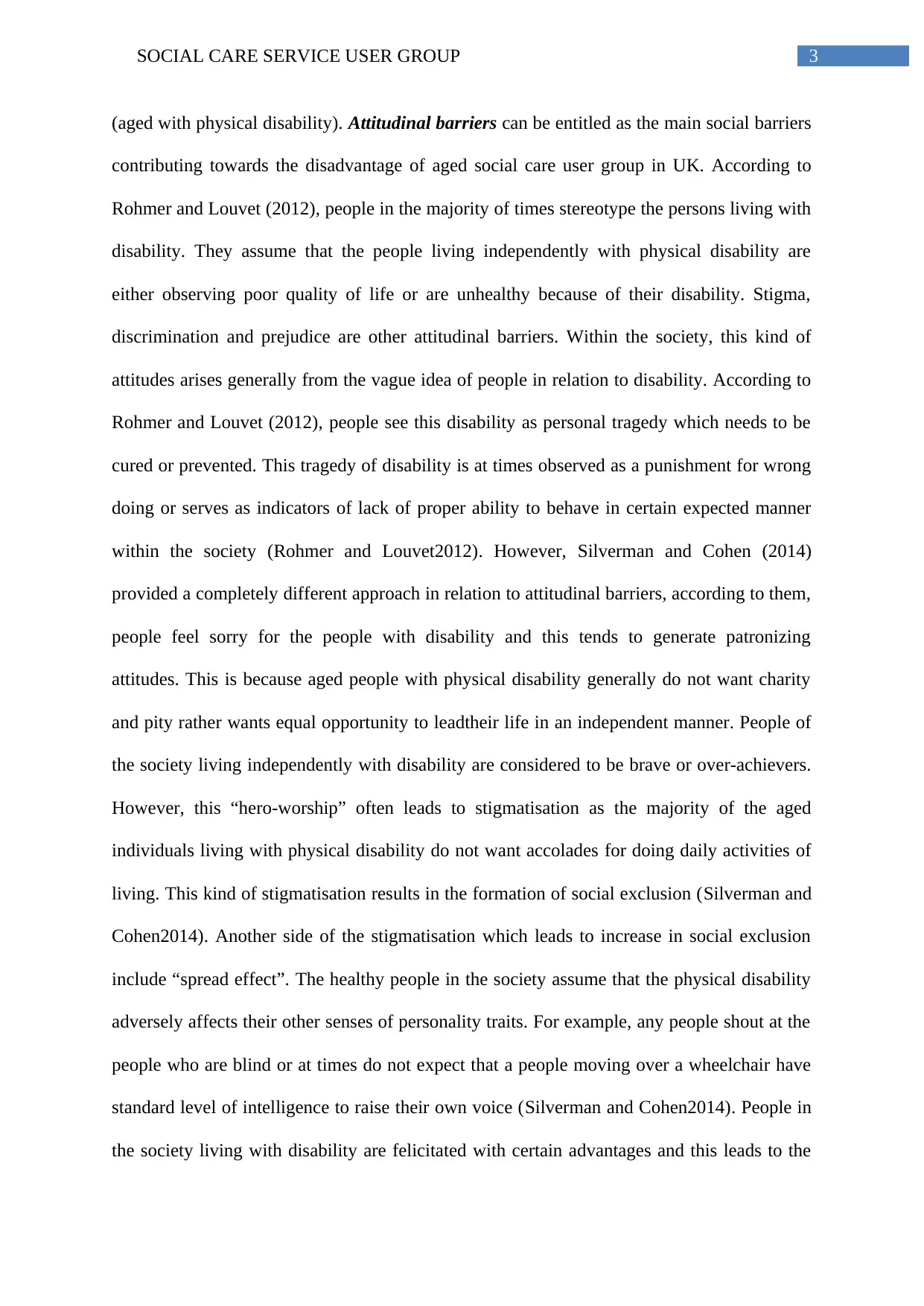
3SOCIAL CARE SERVICE USER GROUP
(aged with physical disability). Attitudinal barriers can be entitled as the main social barriers
contributing towards the disadvantage of aged social care user group in UK. According to
Rohmer and Louvet (2012), people in the majority of times stereotype the persons living with
disability. They assume that the people living independently with physical disability are
either observing poor quality of life or are unhealthy because of their disability. Stigma,
discrimination and prejudice are other attitudinal barriers. Within the society, this kind of
attitudes arises generally from the vague idea of people in relation to disability. According to
Rohmer and Louvet (2012), people see this disability as personal tragedy which needs to be
cured or prevented. This tragedy of disability is at times observed as a punishment for wrong
doing or serves as indicators of lack of proper ability to behave in certain expected manner
within the society (Rohmer and Louvet2012). However, Silverman and Cohen (2014)
provided a completely different approach in relation to attitudinal barriers, according to them,
people feel sorry for the people with disability and this tends to generate patronizing
attitudes. This is because aged people with physical disability generally do not want charity
and pity rather wants equal opportunity to leadtheir life in an independent manner. People of
the society living independently with disability are considered to be brave or over-achievers.
However, this “hero-worship” often leads to stigmatisation as the majority of the aged
individuals living with physical disability do not want accolades for doing daily activities of
living. This kind of stigmatisation results in the formation of social exclusion (Silverman and
Cohen2014). Another side of the stigmatisation which leads to increase in social exclusion
include “spread effect”. The healthy people in the society assume that the physical disability
adversely affects their other senses of personality traits. For example, any people shout at the
people who are blind or at times do not expect that a people moving over a wheelchair have
standard level of intelligence to raise their own voice (Silverman and Cohen2014). People in
the society living with disability are felicitated with certain advantages and this leads to the
(aged with physical disability). Attitudinal barriers can be entitled as the main social barriers
contributing towards the disadvantage of aged social care user group in UK. According to
Rohmer and Louvet (2012), people in the majority of times stereotype the persons living with
disability. They assume that the people living independently with physical disability are
either observing poor quality of life or are unhealthy because of their disability. Stigma,
discrimination and prejudice are other attitudinal barriers. Within the society, this kind of
attitudes arises generally from the vague idea of people in relation to disability. According to
Rohmer and Louvet (2012), people see this disability as personal tragedy which needs to be
cured or prevented. This tragedy of disability is at times observed as a punishment for wrong
doing or serves as indicators of lack of proper ability to behave in certain expected manner
within the society (Rohmer and Louvet2012). However, Silverman and Cohen (2014)
provided a completely different approach in relation to attitudinal barriers, according to them,
people feel sorry for the people with disability and this tends to generate patronizing
attitudes. This is because aged people with physical disability generally do not want charity
and pity rather wants equal opportunity to leadtheir life in an independent manner. People of
the society living independently with disability are considered to be brave or over-achievers.
However, this “hero-worship” often leads to stigmatisation as the majority of the aged
individuals living with physical disability do not want accolades for doing daily activities of
living. This kind of stigmatisation results in the formation of social exclusion (Silverman and
Cohen2014). Another side of the stigmatisation which leads to increase in social exclusion
include “spread effect”. The healthy people in the society assume that the physical disability
adversely affects their other senses of personality traits. For example, any people shout at the
people who are blind or at times do not expect that a people moving over a wheelchair have
standard level of intelligence to raise their own voice (Silverman and Cohen2014). People in
the society living with disability are felicitated with certain advantages and this leads to the
Paraphrase This Document
Need a fresh take? Get an instant paraphrase of this document with our AI Paraphraser
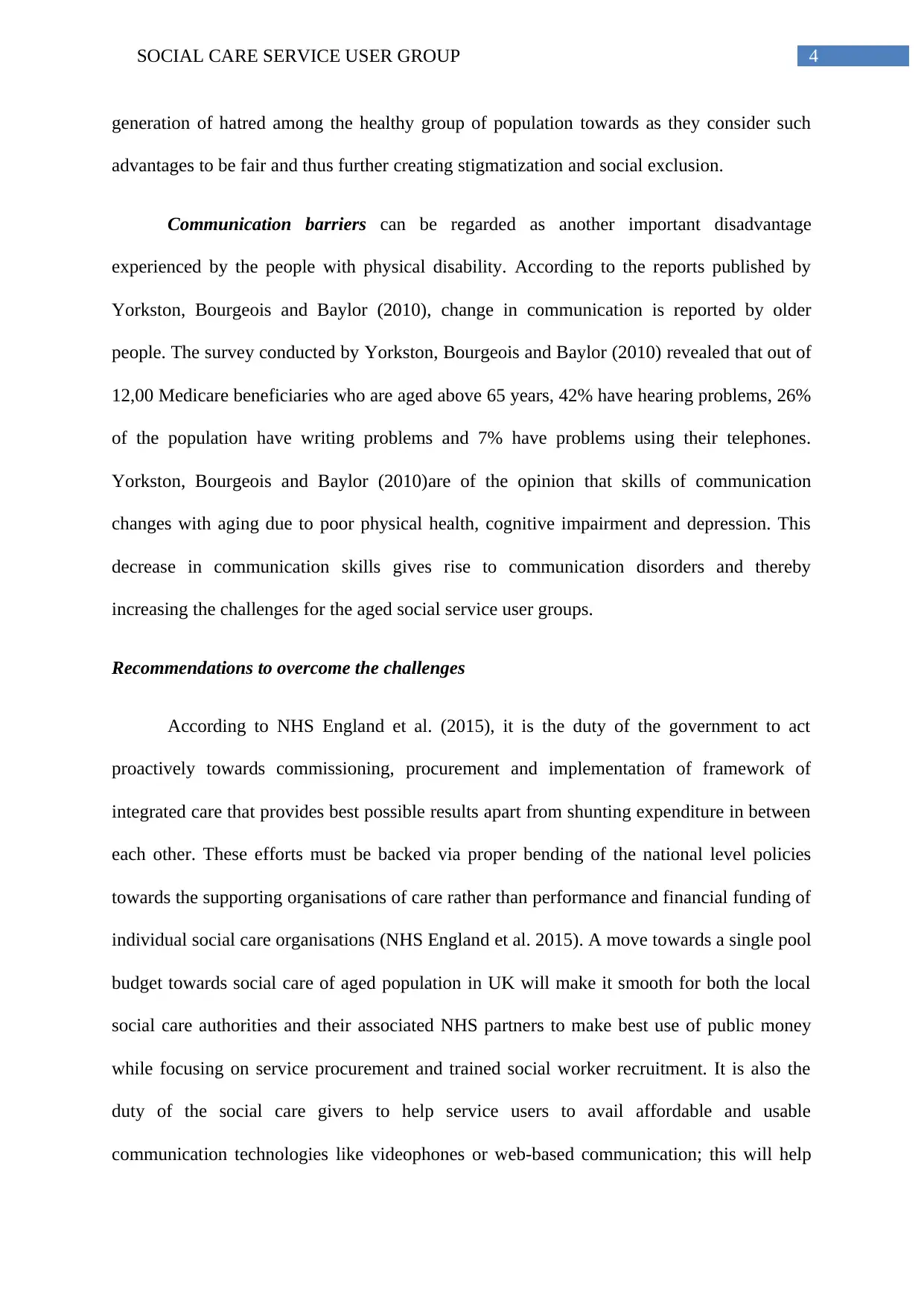
4SOCIAL CARE SERVICE USER GROUP
generation of hatred among the healthy group of population towards as they consider such
advantages to be fair and thus further creating stigmatization and social exclusion.
Communication barriers can be regarded as another important disadvantage
experienced by the people with physical disability. According to the reports published by
Yorkston, Bourgeois and Baylor (2010), change in communication is reported by older
people. The survey conducted by Yorkston, Bourgeois and Baylor (2010) revealed that out of
12,00 Medicare beneficiaries who are aged above 65 years, 42% have hearing problems, 26%
of the population have writing problems and 7% have problems using their telephones.
Yorkston, Bourgeois and Baylor (2010)are of the opinion that skills of communication
changes with aging due to poor physical health, cognitive impairment and depression. This
decrease in communication skills gives rise to communication disorders and thereby
increasing the challenges for the aged social service user groups.
Recommendations to overcome the challenges
According to NHS England et al. (2015), it is the duty of the government to act
proactively towards commissioning, procurement and implementation of framework of
integrated care that provides best possible results apart from shunting expenditure in between
each other. These efforts must be backed via proper bending of the national level policies
towards the supporting organisations of care rather than performance and financial funding of
individual social care organisations (NHS England et al. 2015). A move towards a single pool
budget towards social care of aged population in UK will make it smooth for both the local
social care authorities and their associated NHS partners to make best use of public money
while focusing on service procurement and trained social worker recruitment. It is also the
duty of the social care givers to help service users to avail affordable and usable
communication technologies like videophones or web-based communication; this will help
generation of hatred among the healthy group of population towards as they consider such
advantages to be fair and thus further creating stigmatization and social exclusion.
Communication barriers can be regarded as another important disadvantage
experienced by the people with physical disability. According to the reports published by
Yorkston, Bourgeois and Baylor (2010), change in communication is reported by older
people. The survey conducted by Yorkston, Bourgeois and Baylor (2010) revealed that out of
12,00 Medicare beneficiaries who are aged above 65 years, 42% have hearing problems, 26%
of the population have writing problems and 7% have problems using their telephones.
Yorkston, Bourgeois and Baylor (2010)are of the opinion that skills of communication
changes with aging due to poor physical health, cognitive impairment and depression. This
decrease in communication skills gives rise to communication disorders and thereby
increasing the challenges for the aged social service user groups.
Recommendations to overcome the challenges
According to NHS England et al. (2015), it is the duty of the government to act
proactively towards commissioning, procurement and implementation of framework of
integrated care that provides best possible results apart from shunting expenditure in between
each other. These efforts must be backed via proper bending of the national level policies
towards the supporting organisations of care rather than performance and financial funding of
individual social care organisations (NHS England et al. 2015). A move towards a single pool
budget towards social care of aged population in UK will make it smooth for both the local
social care authorities and their associated NHS partners to make best use of public money
while focusing on service procurement and trained social worker recruitment. It is also the
duty of the social care givers to help service users to avail affordable and usable
communication technologies like videophones or web-based communication; this will help
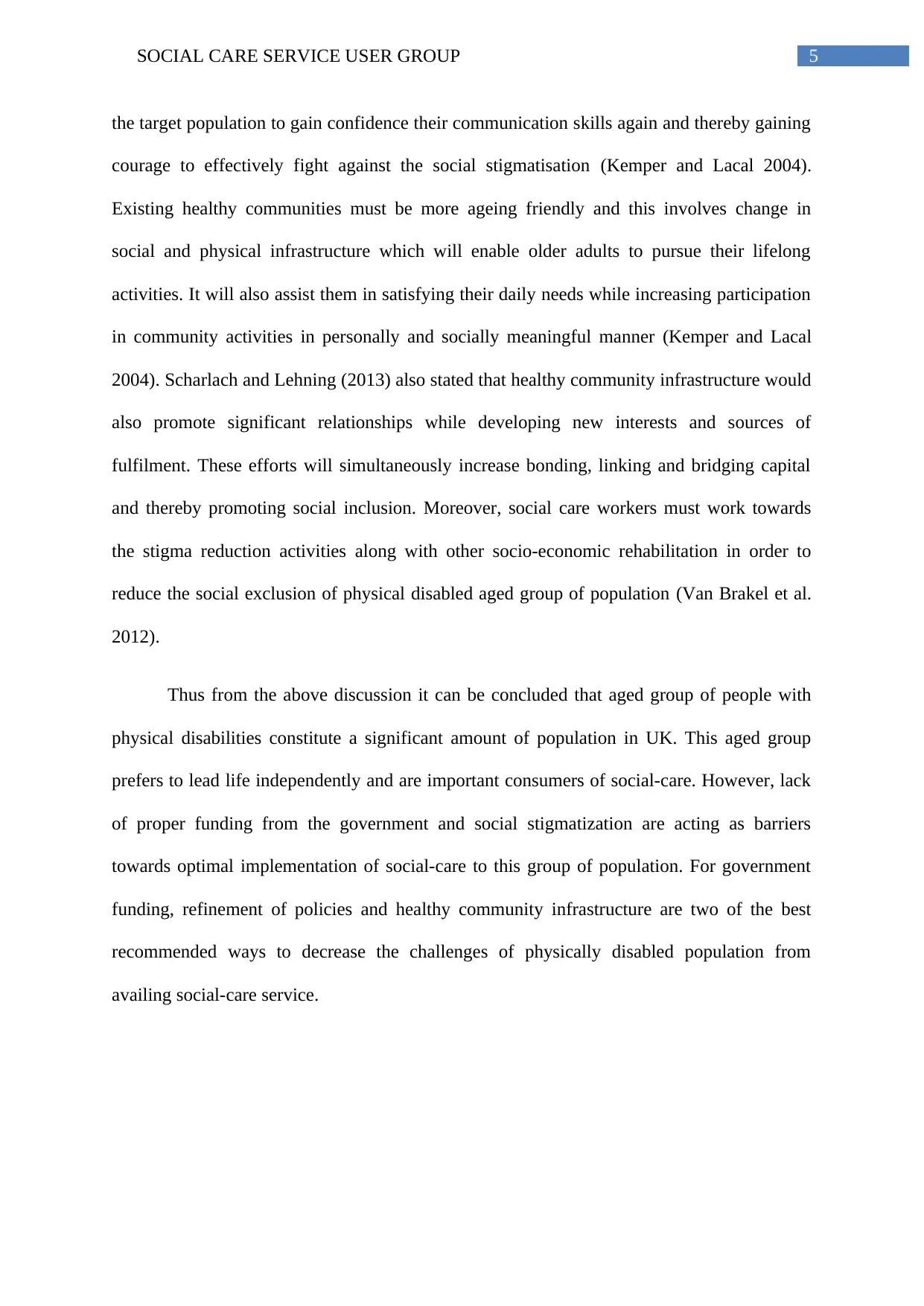
5SOCIAL CARE SERVICE USER GROUP
the target population to gain confidence their communication skills again and thereby gaining
courage to effectively fight against the social stigmatisation (Kemper and Lacal 2004).
Existing healthy communities must be more ageing friendly and this involves change in
social and physical infrastructure which will enable older adults to pursue their lifelong
activities. It will also assist them in satisfying their daily needs while increasing participation
in community activities in personally and socially meaningful manner (Kemper and Lacal
2004). Scharlach and Lehning (2013) also stated that healthy community infrastructure would
also promote significant relationships while developing new interests and sources of
fulfilment. These efforts will simultaneously increase bonding, linking and bridging capital
and thereby promoting social inclusion. Moreover, social care workers must work towards
the stigma reduction activities along with other socio-economic rehabilitation in order to
reduce the social exclusion of physical disabled aged group of population (Van Brakel et al.
2012).
Thus from the above discussion it can be concluded that aged group of people with
physical disabilities constitute a significant amount of population in UK. This aged group
prefers to lead life independently and are important consumers of social-care. However, lack
of proper funding from the government and social stigmatization are acting as barriers
towards optimal implementation of social-care to this group of population. For government
funding, refinement of policies and healthy community infrastructure are two of the best
recommended ways to decrease the challenges of physically disabled population from
availing social-care service.
the target population to gain confidence their communication skills again and thereby gaining
courage to effectively fight against the social stigmatisation (Kemper and Lacal 2004).
Existing healthy communities must be more ageing friendly and this involves change in
social and physical infrastructure which will enable older adults to pursue their lifelong
activities. It will also assist them in satisfying their daily needs while increasing participation
in community activities in personally and socially meaningful manner (Kemper and Lacal
2004). Scharlach and Lehning (2013) also stated that healthy community infrastructure would
also promote significant relationships while developing new interests and sources of
fulfilment. These efforts will simultaneously increase bonding, linking and bridging capital
and thereby promoting social inclusion. Moreover, social care workers must work towards
the stigma reduction activities along with other socio-economic rehabilitation in order to
reduce the social exclusion of physical disabled aged group of population (Van Brakel et al.
2012).
Thus from the above discussion it can be concluded that aged group of people with
physical disabilities constitute a significant amount of population in UK. This aged group
prefers to lead life independently and are important consumers of social-care. However, lack
of proper funding from the government and social stigmatization are acting as barriers
towards optimal implementation of social-care to this group of population. For government
funding, refinement of policies and healthy community infrastructure are two of the best
recommended ways to decrease the challenges of physically disabled population from
availing social-care service.
⊘ This is a preview!⊘
Do you want full access?
Subscribe today to unlock all pages.

Trusted by 1+ million students worldwide
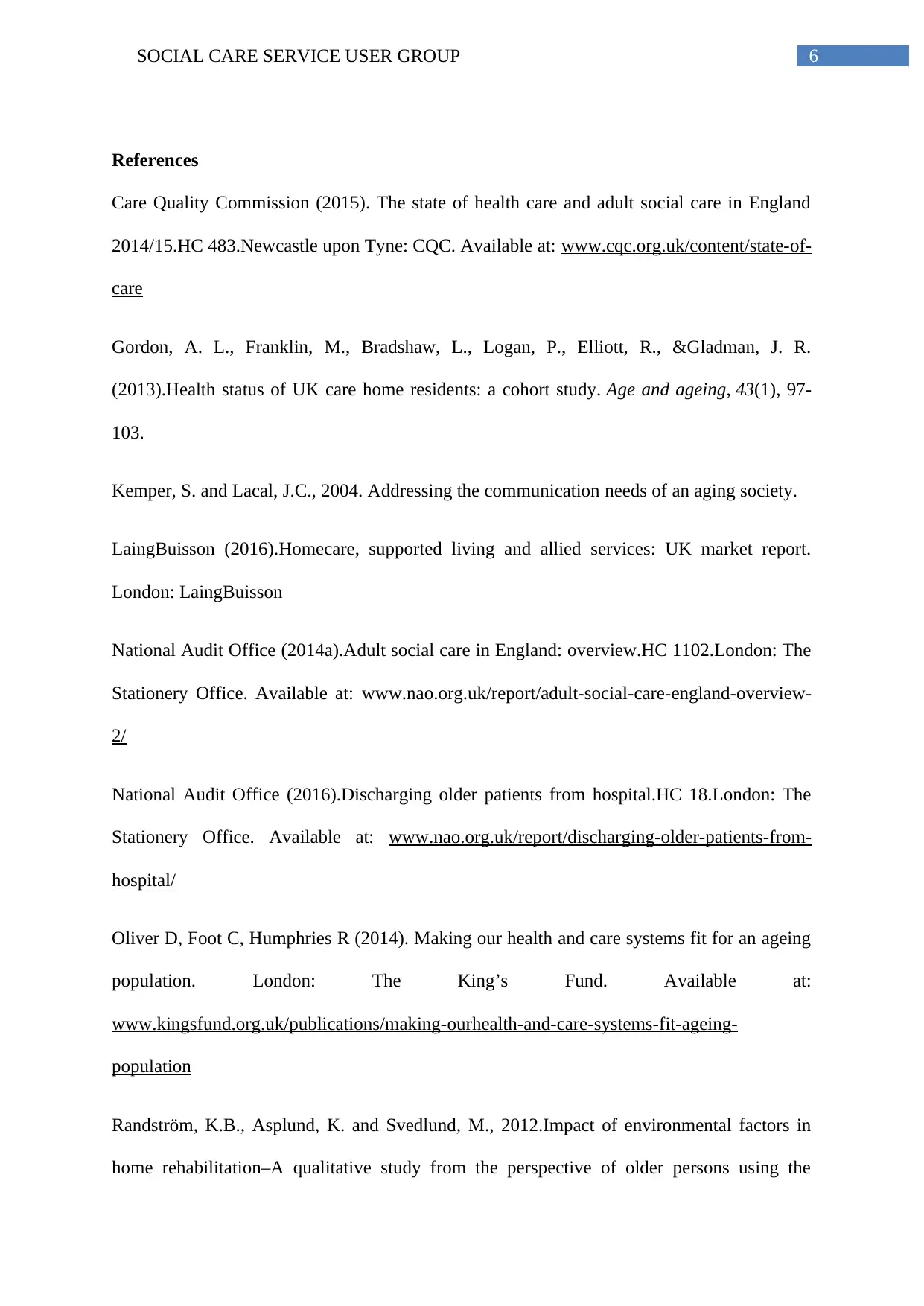
6SOCIAL CARE SERVICE USER GROUP
References
Care Quality Commission (2015). The state of health care and adult social care in England
2014/15.HC 483.Newcastle upon Tyne: CQC. Available at: www.cqc.org.uk/content/state-of-
care
Gordon, A. L., Franklin, M., Bradshaw, L., Logan, P., Elliott, R., &Gladman, J. R.
(2013).Health status of UK care home residents: a cohort study. Age and ageing, 43(1), 97-
103.
Kemper, S. and Lacal, J.C., 2004. Addressing the communication needs of an aging society.
LaingBuisson (2016).Homecare, supported living and allied services: UK market report.
London: LaingBuisson
National Audit Office (2014a).Adult social care in England: overview.HC 1102.London: The
Stationery Office. Available at: www.nao.org.uk/report/adult-social-care-england-overview-
2/
National Audit Office (2016).Discharging older patients from hospital.HC 18.London: The
Stationery Office. Available at: www.nao.org.uk/report/discharging-older-patients-from-
hospital/
Oliver D, Foot C, Humphries R (2014). Making our health and care systems fit for an ageing
population. London: The King’s Fund. Available at:
www.kingsfund.org.uk/publications/making-ourhealth-and-care-systems-fit-ageing-
population
Randström, K.B., Asplund, K. and Svedlund, M., 2012.Impact of environmental factors in
home rehabilitation–A qualitative study from the perspective of older persons using the
References
Care Quality Commission (2015). The state of health care and adult social care in England
2014/15.HC 483.Newcastle upon Tyne: CQC. Available at: www.cqc.org.uk/content/state-of-
care
Gordon, A. L., Franklin, M., Bradshaw, L., Logan, P., Elliott, R., &Gladman, J. R.
(2013).Health status of UK care home residents: a cohort study. Age and ageing, 43(1), 97-
103.
Kemper, S. and Lacal, J.C., 2004. Addressing the communication needs of an aging society.
LaingBuisson (2016).Homecare, supported living and allied services: UK market report.
London: LaingBuisson
National Audit Office (2014a).Adult social care in England: overview.HC 1102.London: The
Stationery Office. Available at: www.nao.org.uk/report/adult-social-care-england-overview-
2/
National Audit Office (2016).Discharging older patients from hospital.HC 18.London: The
Stationery Office. Available at: www.nao.org.uk/report/discharging-older-patients-from-
hospital/
Oliver D, Foot C, Humphries R (2014). Making our health and care systems fit for an ageing
population. London: The King’s Fund. Available at:
www.kingsfund.org.uk/publications/making-ourhealth-and-care-systems-fit-ageing-
population
Randström, K.B., Asplund, K. and Svedlund, M., 2012.Impact of environmental factors in
home rehabilitation–A qualitative study from the perspective of older persons using the
Paraphrase This Document
Need a fresh take? Get an instant paraphrase of this document with our AI Paraphraser
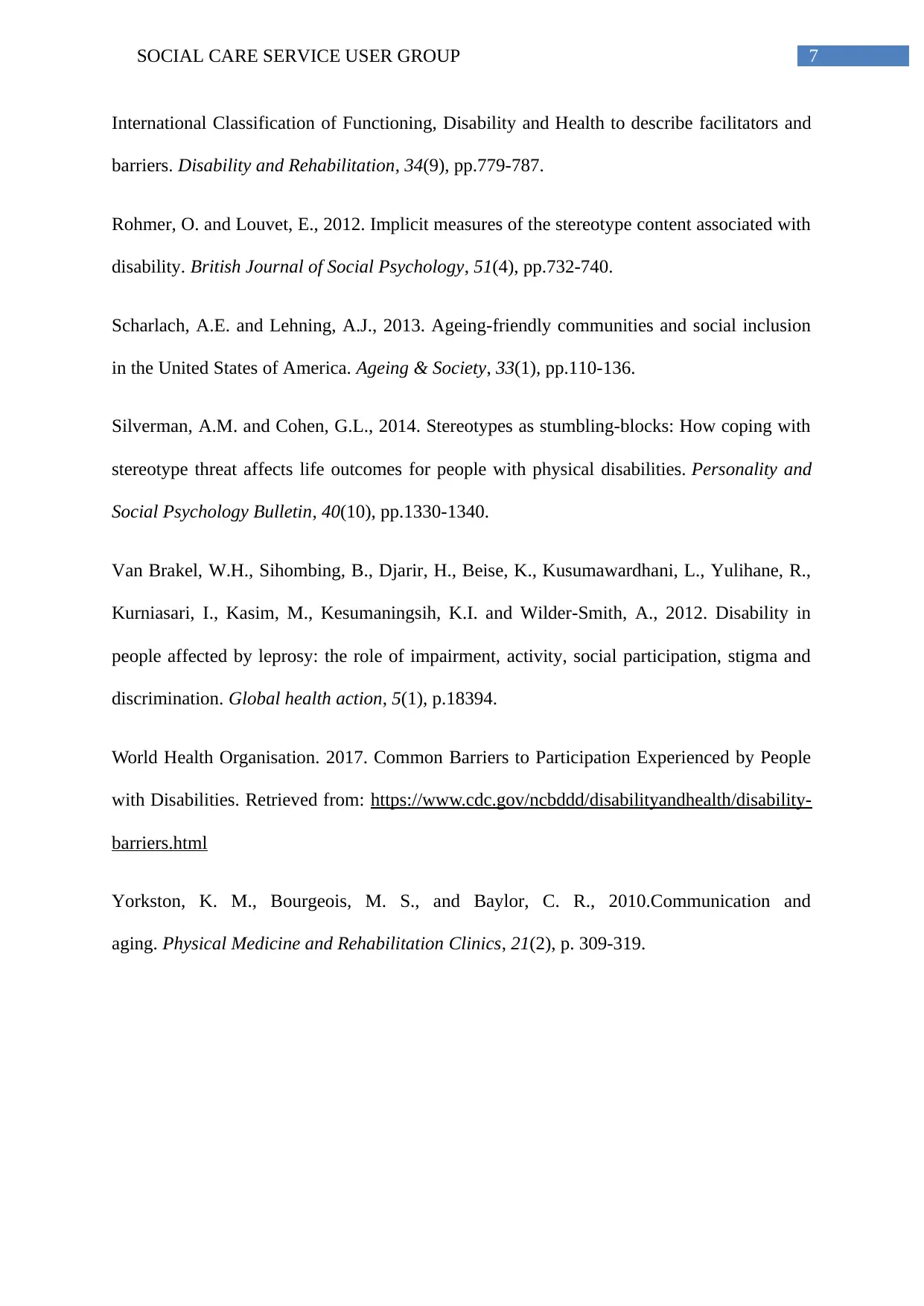
7SOCIAL CARE SERVICE USER GROUP
International Classification of Functioning, Disability and Health to describe facilitators and
barriers. Disability and Rehabilitation, 34(9), pp.779-787.
Rohmer, O. and Louvet, E., 2012. Implicit measures of the stereotype content associated with
disability. British Journal of Social Psychology, 51(4), pp.732-740.
Scharlach, A.E. and Lehning, A.J., 2013. Ageing-friendly communities and social inclusion
in the United States of America. Ageing & Society, 33(1), pp.110-136.
Silverman, A.M. and Cohen, G.L., 2014. Stereotypes as stumbling-blocks: How coping with
stereotype threat affects life outcomes for people with physical disabilities. Personality and
Social Psychology Bulletin, 40(10), pp.1330-1340.
Van Brakel, W.H., Sihombing, B., Djarir, H., Beise, K., Kusumawardhani, L., Yulihane, R.,
Kurniasari, I., Kasim, M., Kesumaningsih, K.I. and Wilder-Smith, A., 2012. Disability in
people affected by leprosy: the role of impairment, activity, social participation, stigma and
discrimination. Global health action, 5(1), p.18394.
World Health Organisation. 2017. Common Barriers to Participation Experienced by People
with Disabilities. Retrieved from: https://www.cdc.gov/ncbddd/disabilityandhealth/disability-
barriers.html
Yorkston, K. M., Bourgeois, M. S., and Baylor, C. R., 2010.Communication and
aging. Physical Medicine and Rehabilitation Clinics, 21(2), p. 309-319.
International Classification of Functioning, Disability and Health to describe facilitators and
barriers. Disability and Rehabilitation, 34(9), pp.779-787.
Rohmer, O. and Louvet, E., 2012. Implicit measures of the stereotype content associated with
disability. British Journal of Social Psychology, 51(4), pp.732-740.
Scharlach, A.E. and Lehning, A.J., 2013. Ageing-friendly communities and social inclusion
in the United States of America. Ageing & Society, 33(1), pp.110-136.
Silverman, A.M. and Cohen, G.L., 2014. Stereotypes as stumbling-blocks: How coping with
stereotype threat affects life outcomes for people with physical disabilities. Personality and
Social Psychology Bulletin, 40(10), pp.1330-1340.
Van Brakel, W.H., Sihombing, B., Djarir, H., Beise, K., Kusumawardhani, L., Yulihane, R.,
Kurniasari, I., Kasim, M., Kesumaningsih, K.I. and Wilder-Smith, A., 2012. Disability in
people affected by leprosy: the role of impairment, activity, social participation, stigma and
discrimination. Global health action, 5(1), p.18394.
World Health Organisation. 2017. Common Barriers to Participation Experienced by People
with Disabilities. Retrieved from: https://www.cdc.gov/ncbddd/disabilityandhealth/disability-
barriers.html
Yorkston, K. M., Bourgeois, M. S., and Baylor, C. R., 2010.Communication and
aging. Physical Medicine and Rehabilitation Clinics, 21(2), p. 309-319.
1 out of 8
Related Documents
Your All-in-One AI-Powered Toolkit for Academic Success.
+13062052269
info@desklib.com
Available 24*7 on WhatsApp / Email
![[object Object]](/_next/static/media/star-bottom.7253800d.svg)
Unlock your academic potential
Copyright © 2020–2025 A2Z Services. All Rights Reserved. Developed and managed by ZUCOL.





